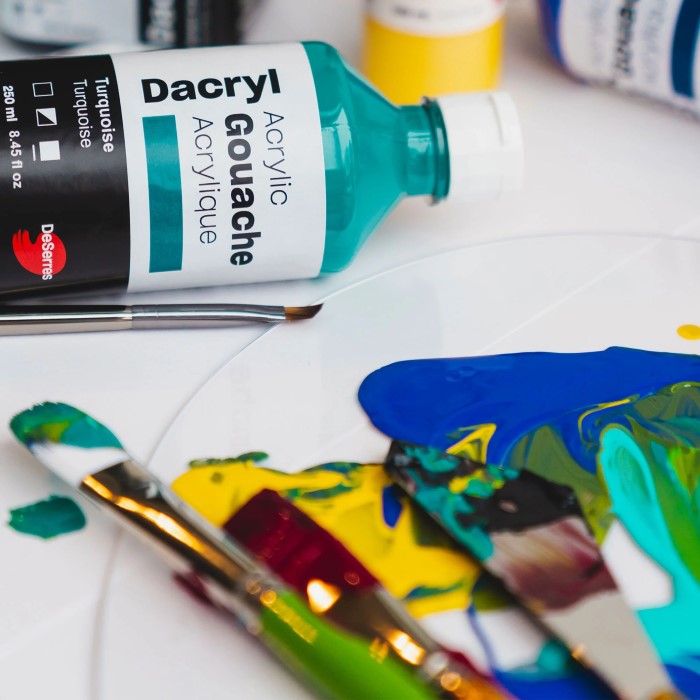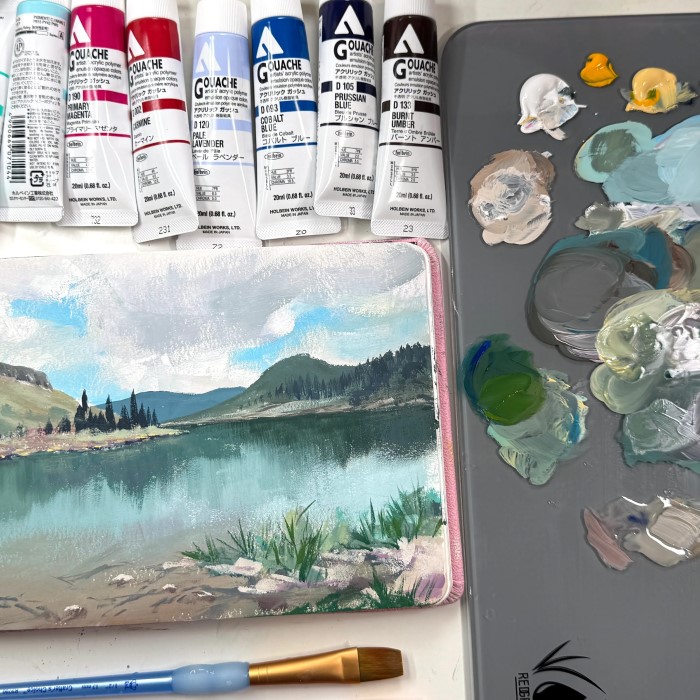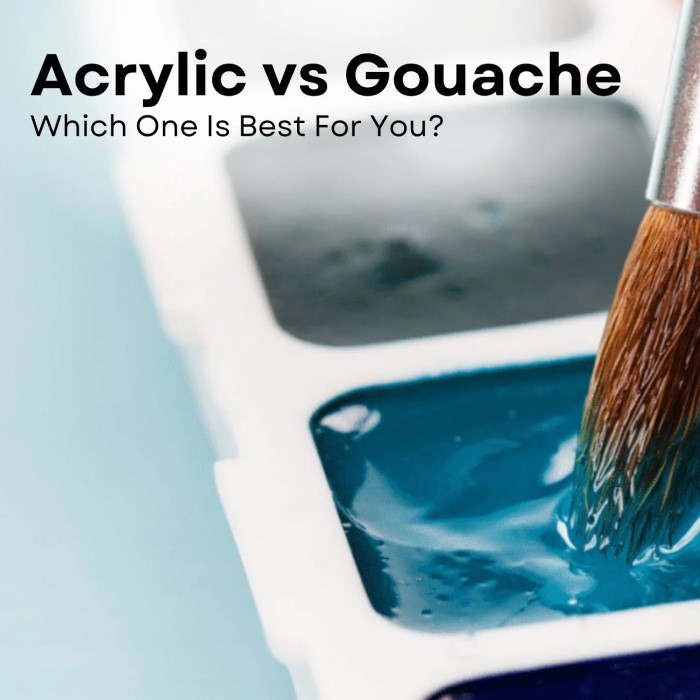Introduction: Understanding the Basics
When exploring the world of painting, two popular mediums often come up: gouache paint vs acrylic. Both have unique characteristics that can affect your artwork, and choosing the right one is crucial for achieving your desired results. This article will dive into the key differences between these two mediums, detailing their properties, applications, and advantages. By the end, you’ll have a clearer understanding, allowing you to choose the best paint for your artistic endeavors.
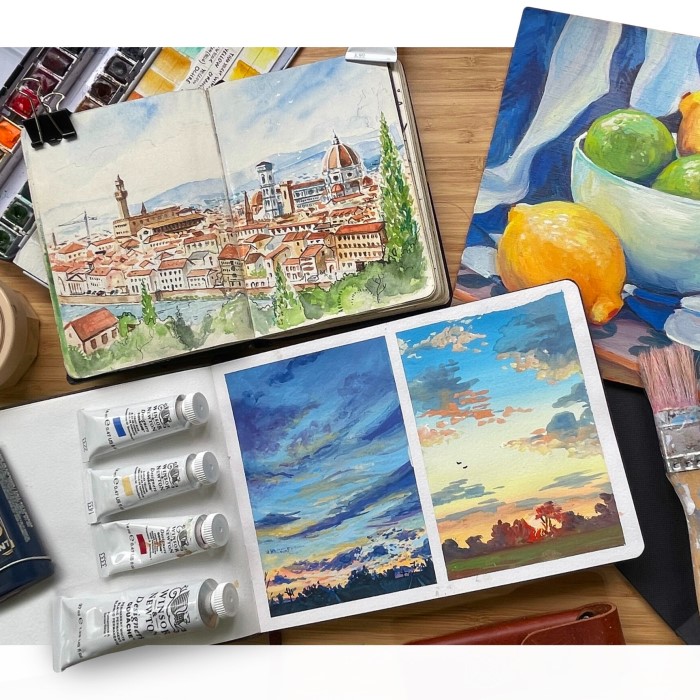
What is Gouache Paint?
Gouache paint is a versatile medium with a rich history and unique properties. Artists often use it for creating vivid, matte finishes. Its water-based composition allows easy manipulation and quick drying times. Below, let’s explore its origins, uses, and pros and cons.
Origins and Characteristics of Gouache
Gouache has been used for centuries, dating back to ancient art practices. It evolved from watercolor, with added white pigment making it opaque. Its main components are pigment, water, and a binding agent like gum arabic. Gouache dries to a smooth, matte finish, with colors that appear richer and more vibrant compared to watercolors. This makes it ideal for designs requiring bold color and flat coverage. Artists can also re-wet dried gouache for adjustments or layering.
Common Uses for Gouache Paint
Gouache is favored for both traditional and digital-inspired art projects. Illustrators, designers, and fine artists commonly use it. Here are its primary applications:
- Illustrations: Its opacity makes layering and bold designs easy.
- Posters and Advertising: Bold, smooth finishes attract attention.
- Sketches and Studies: Artists use it to develop concepts quickly.
- Fine Art Painting: Supports detailed work and flat color fields.
- Calligraphy or Typography Art: Works well for decorative text designs.
In comparison to acrylics, gouache offers better reworkability and smoother blending.
Advantages and Limitations of Gouache
Advantages:
- Easy to blend and rework.
- Dries quickly for faster workflow.
- Offers a smooth, matte, and non-reflective finish.
- Compatible with various surfaces like paper and board.
- Affordable and beginner-friendly.
Limitations:
- Can crack if applied thickly.
- Less durable compared to acrylic paint.
- Not waterproof when dry, meaning it can smudge with water exposure.
- Limited to smaller-scale projects for best results.
Understanding gouache’s strengths and weaknesses helps artists decide its suitability for specific projects. This comparison with acrylic paint showcases its unique qualities.
What is Acrylic Paint?
Acrylic paint is a popular medium known for its vibrant colors and versatility. It is water-based, dries quickly, and can adhere to a range of surfaces. Below, let’s explore its properties, common uses, and advantages and disadvantages.
Overview and Properties of Acrylic Paint
Acrylic paint was first introduced in the mid-20th century. Its main components are pigment, a water-soluble binder (acrylic polymer), and water. Once dry, acrylic becomes water-resistant and highly durable. This property sets it apart from gouache paint vs acrylic in terms of longevity.
Acrylic paint is adaptable to different effects. Artists can use it thickly for textures or thin it out for washes. It dries to a glossy or semi-glossy finish, depending on the formulation. This versatility makes it suitable for both fine art and practical projects, such as murals and furniture.
Popular Applications for Acrylic Paint
Acrylic paint is used in various artistic and practical projects. Here are its primary applications:
- Canvas Painting: Favored by fine artists for professional works.
- Mixed Media Art: Works well with materials like charcoal, ink, or even tissue paper.
- Murals: Its durability suits long-lasting wall paintings, both indoors and outdoors.
- Decorative Crafts: Ideal for furniture, pottery, and more.
- Fabric Painting: Stays on fabric after using proper mediums for adhesion.
The versatility of acrylics gives it an edge over gouache in creating durable, large-scale, or three-dimensional work.
Benefits and Drawbacks of Acrylic
Benefits:
- Waterproof and long-lasting once dry.
- Can create multiple effects like textures or thin washes.
- Adheres well to various surfaces including wood, paper, canvas, and plastic.
- Dries faster than most paints, enabling quick projects.
Drawbacks:
- Dries quickly, limiting reworkability or blending on the canvas.
- Requires more specialized tools for cleaning, e.g., wet cloth or soap.
- Less beginner-friendly compared to gouache paint due to its fast drying nature.
- Can become brittle over time if applied very thickly.
Understanding acrylic’s strengths and weaknesses helps artists decide its suitability for their projects. Compared to gouache, acrylic offers more durability but less flexibility for reworking.
Key Differences Between Gouache and Acrylic
Composition and Pigment Differences
Gouache and acrylic paints differ in their core composition. Gouache is water-based, made with pigment, gum arabic, and water. It includes added white pigment for opacity. Acrylic paint uses pigment mixed with an acrylic polymer binder and water. Once dry, acrylic becomes water-resistant and durable, which is not the case for gouache. These compositional differences influence their behavior in art projects.
Texture and Finish Comparison
The textures and finishes of gouache and acrylic vary significantly. Gouache dries to a smooth, matte finish, making it ideal for flat color applications. It has a soft texture that is easy to rework. Acrylic, on the other hand, dries to a glossy or semi-glossy finish, adding vibrancy and shine to artworks. It can be applied thickly for textures or used thinly for washes. Choosing between these two depends on the desired aesthetic outcome.
Permanence and Longevity
Acrylic paint is more durable and water-resistant once dry, making it ideal for long-lasting pieces. It is suitable for both indoor and outdoor applications like murals. Gouache does not offer the same permanence and may smudge if exposed to water. It is less durable and prone to cracking when applied thickly. Acrylic projects typically withstand environmental conditions better than gouache.
Blending and Layering Capabilities
Blending and layering are easier with gouache due to its re-wettable nature. Artists can adjust dried strokes with water, creating smoother transitions. Gouache is excellent for detailed layering in illustrations or studies. Acrylic dries faster and is more challenging to blend once dry. Although layering is possible, the quick drying time requires precise planning. Acrylic excels in creating textures but limits reworkability compared to gouache.
Choosing Between Gouache and Acrylic
When deciding between gouache paint vs acrylic, understanding their properties and best use scenarios is crucial. Each offers distinct advantages depending on the artist’s needs and project requirements.
Factors to Consider When Selecting a Paint Type
- Durability and Water Resistance: Acrylic is ideal if longevity is important, as it is waterproof and less prone to damage. Gouache, though vibrant, is re-wettable and can smudge once dry.
- Finish and Texture: Choose gouache for a matte, smooth finish. Acrylic offers glossy or semi-glossy results that add shine.
- Reworkability: Gouache allows for re-wettable layering and blending, making it beginner-friendly. Acrylic dries fast, limiting adjustments.
- Scale and Application: Acrylic suits large-scale projects like murals or furniture. Gouache excels in smaller, detailed designs like illustrations or calligraphy.
- Budget and Materials: Gouache is cost-effective and requires fewer tools. Acrylic may demand more specialized materials, increasing overall cost.
Best Projects for Gouache Painting
Gouache shines in projects requiring precision and bold designs. Here are some ideal uses:
- Illustrations and Concept Art: Perfect for detailed drawings with vivid colors.
- Calligraphy and Typography: Gouache’s smooth finish enhances decorative text.
- Posters or Advertising: Ideal for flat color applications that stand out.
- Sketches and Studies: Quick drying time aids initial drafts or experimentation.
Artists favor gouache for intricate and small-scale projects due to its versatility and ease of reworking.
Ideal Scenarios for Acrylic Painting
Acrylic suits projects demanding durability and vibrant finishes. Best applications include:
- Large Murals: Acrylic is weather-resistant, making it great for indoor and outdoor wall art.
- Mixed Media Art: Works well with diverse materials like ink or texture mediums.
- Canvas Art: Supports bold strokes and layered effects for professional artworks.
- Fabric and Craft Projects: Stays on fabric when used with appropriate mediums.
For large-scale, long-lasting, or high-impact works, acrylic outperforms gouache in durability and flexibility.
Selecting between gouache and acrylic ultimately depends on the artist’s goals, project size, and required outcomes.
Tools and Techniques for Gouache and Acrylic Painting
Selecting the right tools and mastering techniques is essential for both gouache and acrylic painting. Each medium requires a tailored approach to achieve the best results. Below, we’ll explore tools and techniques to enhance your painting experience.
Essential Tools for Gouache Painting
To get started with gouache painting, you’ll need a simple, cost-effective setup. Here are the must-have tools:
- High-Quality Gouache Paints: Invest in artist-grade paints for better color vibrancy and opacity.
- Brushes: Use soft, synthetic brushes that hold water well, ideal for smooth application.
- Watercolor Paper or Boards: Thick, textured paper ensures the paint doesn’t warp the surface.
- Palette: Opt for flat palettes or mixing trays to blend colors easily.
- Water Jars: Keep one jar for cleaning brushes and another for clean mixing water.
- Paper Towels: Use them for blotting brushes and correcting mistakes.
- Masking Tape: Secure paper edges to keep them flat while painting.
Having the right gouache tools ensures smooth blending, layering, and vibrant designs.
Must-Have Supplies for Acrylic Painting
Acrylic painting requires slightly different materials, given the medium’s thicker consistency and fast drying time. Here’s what you’ll need:
- Acrylic Paints: Choose a variety of colors, including heavy body and fluid formulations.
- Mediums: Acrylic gel, matte medium, or glaze medium can alter paint thickness and finish.
- Brushes: Use firm, synthetic brushes designed for acrylics to handle thicker textures.
- Canvas or Other Surfaces: Acrylic adheres to canvas, wood, plastic, and more.
- Palette: A wet palette prevents acrylic paints from drying quickly.
- Spray Bottle: Use it to keep paints moist while working.
- Palette Knives: These are great for mixing paints or creating textured effects.
- Protective Clothing: Acrylic can stain, so wear an apron or old clothes.
Equipped with these supplies, you can explore acrylic’s versatility and durability.
Unique Techniques for Each Paint Type
Mastering techniques can greatly elevate your artwork, no matter the medium:
Techniques for Gouache Painting:
- Layering: Let previous layers dry before adding new ones for richer, matte finishes.
- Wet-on-Wet: Apply wet gouache to a wet surface for soft blending.
- Dry Brush: Use minimal water for textured, sketch-like strokes.
- Highlighting: Rewet dried areas for easy detail adjustments.
Techniques for Acrylic Painting:
- Impasto: Apply thick paint with a palette knife for textured, three-dimensional effects.
- Wash Technique: Dilute acrylic paint with water for watercolor-like transparency.
- Stippling: Use a brush tip or sponge to create dotted textures.
- Blending: Work quickly to blend colors before they dry for seamless transitions.
Both gouache and acrylic offer unique opportunities for creativity. Choosing the right tools and techniques ensures better results tailored to your artistic vision.
Tips for Beginners: Getting Started with Gouache and Acrylic
Embarking on the journey of painting with gouache or acrylic can be exciting yet challenging. Setting yourself up with the right environment, practicing essential exercises, and avoiding common pitfalls will help you make the process smoother and more enjoyable.
Setting Up Your Workspace
Creating an organized and inspiring workspace is key to productive painting sessions. Here’s how to set up effectively:
- Choose the Right Location: Find a well-lit, ventilated space with minimal distractions.
- Organize Your Tools: Keep brushes, paints, palettes, and water jars within easy reach.
- Protect Your Area: Use a drop cloth or old newspapers to shield surfaces from paint spills.
- Adjust Your Lighting: Use natural or adjustable lamps for accurate color visibility.
- Comfortable Seating: Invest in an ergonomic chair or stand to avoid discomfort during longer sessions.
- Storage Solutions: Use containers or drawers to neatly store paints and supplies when not in use.
An efficient workspace ensures you focus on creativity rather than managing clutter.
Practice Exercises for Mastering Each Paint Type
Practicing foundational techniques prepares you for more complex artistic works. Here are tailored exercises for both gouache and acrylic:
For Gouache Beginners:
- Flat Washes: Practice covering areas with uniform color for smooth finishes.
- Layering: Experiment with building colors in multiple layers after each one dries.
- Blending: Try softening transitions between colors while the paint is still wet.
- Rewetting: Test reactivating dried gouache to understand its reworkable nature.
For Acrylic Beginners:
- Consistency Control: Test varying thickness by adding water or mediums to acrylic.
- Basic Textures: Use palette knives or brushes to create a range of surface effects.
- Quick Blends: Work on blending colors before they dry to avoid harsh lines.
- Wash Practice: Dilute acrylic to create translucent layers resembling watercolor washes.
These exercises help build confidence and improve your control over the paint.
Mistakes to Avoid as a Beginner
Knowing common pitfalls can save time and reduce frustration. Avoid the following mistakes:
- Skipping Prep Work: Always prepare your surface (paper, canvas, etc.) to ensure better paint adhesion.
- Using Too Much Water: Avoid oversaturating gouache, which can dilute its vibrancy and opacity.
- Rushing Layers: Let each layer dry before painting over it to prevent muddy colors.
- Neglecting Tools: Clean brushes immediately after use to avoid paint drying on them.
- Ignoring Drying Times: Remember that acrylic dries quickly, while gouache allows more rework time.
- Overloading Brushes: Don’t overwhelm the brush with too much paint, as it reduces control.
By recognizing and avoiding these errors, you’ll develop better habits and hone your skills more effectively.
Conclusion: Which Paint is Right for You?
Choosing between gouache and acrylic depends on your artistic goals and project demands. Each paint offers unique benefits that cater to distinct needs. Here are key takeaways to help make your decision:
- Choose Gouache If:
- You need a reworkable medium for precision and layering.
- You prefer a smooth, matte finish for your art.
- Your projects are small-scale, like illustrations or calligraphy.
- Cost-effectiveness and beginner-friendliness are important factors.
- Choose Acrylic If:
- Durability and water-resistance are essential for your artwork.
- You aim to create large-scale or outdoor projects like murals.
- You enjoy bold, vibrant colors with glossy finishes.
- Experimenting with textures and mixed media excites you.
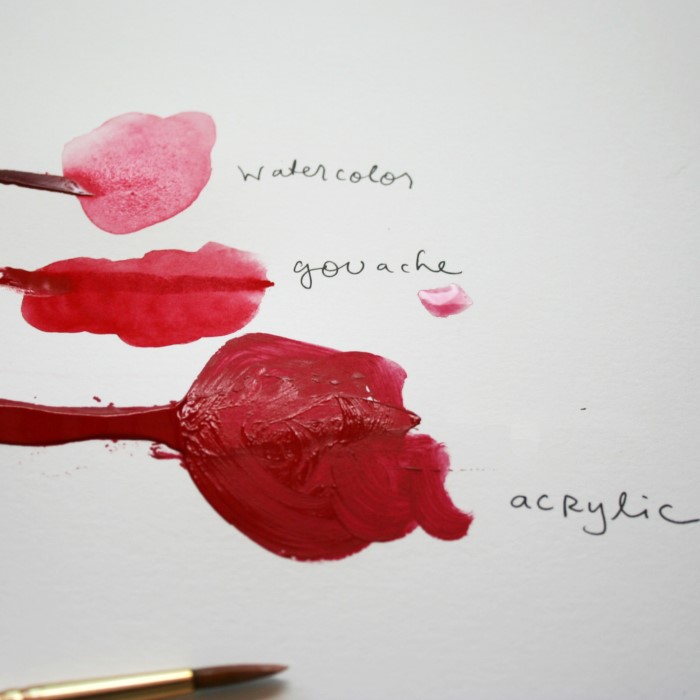
Consider your workflow, style, and intended outcomes when making a choice. Gouache excels at creating detailed or experimental designs with flexibility. Acrylic is perfect for long-lasting, bold artwork, especially on diverse surfaces. Both mediums have distinct advantages, ensuring there is no wrong choice—only what fits your artistic vision!
Final Thoughts: Which to Choose?
Choosing between gouache paint vs acrylic ultimately comes down to your specific needs and artistic goals. If you prefer a matte finish, reworkability, and vibrant opaque colors, gouache might be the better option for you. On the other hand, if you value versatility and fast drying time, acrylic paint may suit your projects better.
Consider experimenting with both mediums to see which aligns with your preferred techniques and artistic style. No matter which you choose, both gouache and acrylic paints offer unique benefits that can enhance your artistic expression.
